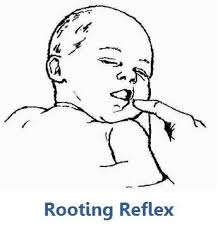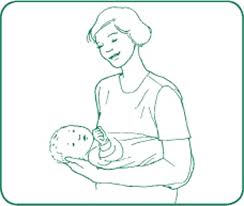Holding a breastfeeding infant can be a challenge for anyone other than the breastfeeding mom. We want to hold babies close to our bodies partially because instinct tells us this is right, and also because of typical media images. Baby books, TV shows and movies all show us the two typical ways to hold babies. One hold makes baby happy (cradle hold) and one sad (out, away from body.) The latter hold is always performed by the unknowing, un-maternal/paternal adult holding a baby straight out, arms fully extended away from their body, and the baby hovering in the air hysterical.
But, what if a less dramatic version of the out-and-away hold is actually better, less upsetting and confusing for the baby?
The reason the cradle, hug-baby-in, hold doesn’t always work for breastfeeding infants is simply because they associate that hold, the closeness of it with breastfeeding. So, instead of the baby becoming calm, she may instead begin to root  (beginning signs she wants to eat) and unless you’re also giving bottles you can’t soothe her in the way she wants. Instead a modified football hold might be best. [Elbow at your side, baby laying longways on your arm, and arm extended out.]
(beginning signs she wants to eat) and unless you’re also giving bottles you can’t soothe her in the way she wants. Instead a modified football hold might be best. [Elbow at your side, baby laying longways on your arm, and arm extended out.]
Signs baby is rooting and therefore likely to become upset with the non-breastfeeding adult:
-Trying to lick or suck on your arm, chest, neck…anywhere.
-Burrowing into your chest, arm.
-Baby rubs hand on your chest/breast.
-Crying when diaper is dry, and has recently slept.
Sometimes infants are perfectly content in the cradle position, but usually only for a limited time. I try to hold b.f. infants in the modified football hold, very high up on my shoulder, and on my legs, while sitting.
Next time you have a fussy infant, and you see any of the rooting signs try changing your hold, so that the baby is away from your chest. If the baby has recently eaten, you’ll find she will likely immidiately be calmed once away from your chest.

